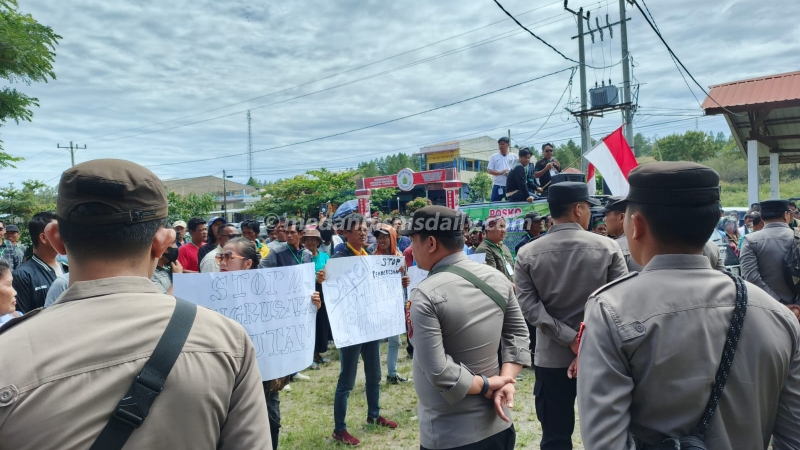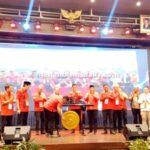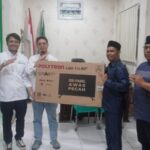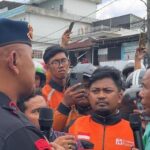Hundreds of residents from 5 villages in Kenegerian Ambarita, Simanindo District, Samosir Regency—namely Ambarita, Garoga, Siallagan Pindaraya, Unjur, and Martoba—held a protest at the Samosir Legislative Council office in Pangururan.
The residents demanded the revocation of the Community Forest Management (HKM) permit held by the company Parna Jaya Sejahtera in Simanindo District, which was issued by the Ministry of Environment and Forestry of the Republic of Indonesia.
They expressed fear to the Samosir Legislative Council that natural disasters like flash floods carrying mud, rocks, and wood debris from the forested hills could happen again.
“A flood occurred several years ago, hitting five villages in Simanindo District, Samosir Regency, suspected to be caused by pine resin tapping activities carried out by the HKM group Parna Jaya Sejahtera,” said residents.
It was also conveyed that the pine resin tapping is suspected to have violated regulations set by the Ministry of Environment and Forestry of the Republic of Indonesia at the HKM permit location owned by Parna Jaya Sejahtera.
Additionally, residents found processed wood materials such as planks and broti wood, the construction of a hut, and the opening of a road in the forest area, suspected to have been carried out by HKM Parna Jaya Sejahtera.
These community findings have also been reported to the police after residents checked the activities at the group’s location.
The residents were received by the Chairman of the Samosir Legislative Council.
The action coordinator, in his speech, urged the Legislative Council and the Samosir Regency Government to press the Ministry of Environment and Forestry of the Republic of Indonesia to immediately revoke the HKM permit for Parna Jaya Sejahtera.
“It is suspected to be the cause of flash floods carrying wood materials and mud, especially during the rainy season,” he emphasized.
As of this report, the Chairman of the Legislative Council along with several council members were still in the legislative meeting room listening to the aspirations and demands of the Kenegerian Ambarita residents.
Kenegerian Ambarita
Kenegerian Ambarita is a traditional Batak village located on Samosir Island in Lake Toba, Indonesia. It is historically significant as the former capital of the Siallagan clan, a group of Batak chieftains. The site is famous for its ancient stone furniture and execution tables, which were used for trials and ceremonies centuries ago.
Samosir Legislative Council
The Samosir Legislative Council is the local government body for Samosir Regency, located on Samosir Island in Lake Toba, Indonesia. It was established as part of Indonesia’s decentralization process to govern the regency, which is the cultural heartland of the Batak people. The council is responsible for creating local regulations and overseeing development in this region famous for its unique indigenous culture and stunning volcanic landscapes.
Ministry of Environment and Forestry of the Republic of Indonesia
The Ministry of Environment and Forestry (KLHK) is a government institution in Indonesia responsible for managing the country’s vast natural resources and environmental policy. It was formed in 2014 through the merger of the former Ministry of Forestry and the Ministry of Environment, consolidating these two critical areas under one authority. This merger was a strategic move to better address the intertwined challenges of sustainable forest management and environmental protection in the archipelago.
Simanindo District
Simanindo District is located on Samosir Island in Lake Toba, Indonesia, and is a significant cultural center for the Batak people. It is historically known as the seat of the former Simalungun Batak kings, with the well-preserved Museum Huta Bolon Simanindo, a traditional Batak royal house, serving as a key attraction. The district offers visitors insights into Batak culture through daily performances of traditional music and the iconic Tor-Tor dance.
Samosir Regency
Samosir Regency is an administrative region located on Samosir Island and part of the mainland in Lake Toba, North Sumatra, Indonesia. It is the cultural heartland of the Batak people, with a history dating back centuries as a center of Batak kingdoms and traditions. The island itself was formed by geological activity related to the Toba supervolcano eruption approximately 74,000 years ago.
Parna Jaya Sejahtera
I am unable to find any significant historical or cultural information about a place or site named “Parna Jaya Sejahtera.” This name does not appear to correspond to a well-known landmark, historical site, or recognized cultural institution. It is possible that it refers to a local business, building, or organization in a specific community.
Ambarita
Ambarita is a traditional Batak village located on Samosir Island in Lake Toba, Indonesia. It is historically significant as the former seat of the Siallagan clan, a line of Batak kings. The site is famous for its ancient stone furniture and execution stones, where tribal leaders once held meetings and dispensed justice.
Garoga
I am unable to find any notable information about a place or cultural site named “Garoga.” It is possible the name is misspelled or refers to a very localized or lesser-known location. Could you please verify the spelling or provide any additional context?






